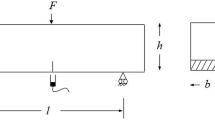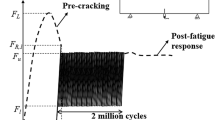Abstract
High density cellulose-based materials have been widely used for electrical insulation and (interior) construction or structural material. Similar to typical paper/board materials, the microstructure of high-density fibre mats consists of a porous network of cellulose fibres, which contributes to its highly non-linear mechanical response. Such fibre mats exhibit strong anisotropic material behaviour as well as significant transient (time- or rate-dependent) behaviour. The present investigation is aimed at studying the transient behaviour of high-density cellulose fibre mats, particularly during out-of-plane compression. A viscoelastic–viscoplastic constitutive model dedicated for high-density cellulose-based materials has been used to simulate the responses of the high-density cellulose-based fibre mats upon two types of transient loading, i.e. compressive creep and stress relaxation. The predictions of the model are then compared to the corresponding experimental characterization results, which indicate that material densification mechanism plays a more critical role during out-of-plane compression creep than in stress relaxation.





Similar content being viewed by others
References
El-Hosseiny F, Page D (1975) The mechanical properties of single wood pulp fibers: theories and strength. Fibre Sci. Technol. 8:21–31
Magnusson MS, Zhang X, Östlund S (2013) Experimental evaluation of the interfibre joint strength of papermaking fibres in terms of manufacturing parameters and in two different loading directions. Exp Mech 53:1621–1634
Wernersson ELG, Borodulina S, Kulachenko A, Borgefors G (2014) Characterisations of fibre networks in paper using micro computed tomography images. Nord Pulp Pap Res J 29:468–475
Kulachenko A, Uesaka T (2012) Direct simulation of fiber network deformation and failure. Mech Mater 51:1–14
Beex LAA, Peerlings RHJ, Geers MGD (2014) A multiscale quasicontinuum method for lattice models with bond failure and fiber sliding. Comput Methods Appl Mech Eng 269:108–122
Silberstein MN, Pai CL, Rutledger GC, Boyce MC (2012) Elastic-plastic behavior of non-woven fibrous mats. J Mech Phys Solids 60:295–318
Borgqvist E, Wallin M, Ristinmaa M, Tryding J (2015) An anisotropic in-plane and out-of-plane elasto-plastic continuum model for paperboard. Compos Struct 126:184–195
Xia QS, Boyce MC, Parks DM (2002) A constitutive model for the anisotropic elastic-plastic deformation of paper and paperboard. Int J Solids Struct 39:4053–4071
Tjahjanto DD, Girlanda O, Östlund S (2015) Anisotropic viscoelastic-viscoplastic continuum model for high-density cellulose-based materials. J Mech Phys Solids 84:1–20
Alfthan J (2010) Experimental study of non-linear stress relaxation and creep of paper materials and the relation between the two types of experiments. Nord Pulp Pap Res J 25(3):351–357
Stenberg N (2003) A model for the through-thickness elastic-plastic behaviour of paper. Int J Solids Struct 40:7483–7498
Åslund PE, Isaksson P (2011) A note on the nonlinear mechanical behavior of planar random network structures subjected to in-plane compression. J Compos Mater 45:2697–2703
Strömbro J, Gudmundson P (2008) Mechano-sorptive creep under compressive loading—a micromechanical model. Int J Solids Struct 45(9):2420–2450
Girlanda O, Tjahjanto DD, Östlund S, Wei K, Schmidt LE (2013) Characterization and modelling of the mechanical properties of pressboard. Electrical Insulation and Dielectric Phenomena (CEIDP), IEEE Conference, Shenchen, pp 563–566
Joffre T, Girlanda O, Forsberg F, Sahlen F, Sjödahl M, Gamstedt EK (2015) A 3D in-situ investigation of the deformation in compressive loading in the thickness direction of cellulose fiber mats. Cellulose 22(5):2993–3001
Coffin DW (2012) Creep and relaxation. In: Niskanen K (ed) Mechanics of paper products. Walter de Gruyter, Berlin/Boston
Alava M, Niskanen K (2006) The physics of paper. Rep Prog Phys 69:669–723
IEC-60641 (2004) Pressboard and presspaper for electrical purposes–Part 1: Definitions and general requirements. International Electrotechnical Commission (IEC), Geneva
IEC-60641 (2004) Pressboard and presspaper for electrical purposes–Part 2: Methods of tests. International Electrotechnical Commission (IEC), Geneva
Banks HT, Hu S, Kenz ZR (2011) A brief review of elasticity and viscoelasticity for solids. Adv Appl Math Mech 3(1):1–51
Miled B, Doghri I, Delannay L (2011) Coupled viscoelastic–viscoplastic modeling of homogeneous and isotropic polymers: numerical algorithm and analytical solutions. Comput Methods Appl Mech Eng 200:3381–3394
Hutchinson JW (1976) Bounds and self-consistent estimates for creep of polycrystalline materials. Proc R Soc Lond A 348:101–127
Stenberg N (2004) Out-of-plane shear of paperboard under high compressive loads. J Pulp Pap Sci 30:22–28
Girlanda O, Tjahjanto DD, Östlund S, Ask A, Forslin J, Schmidt LE (2014) Modeling and experimental validation of the mechanical behavior of pressboard. In: IEEE Electrical Insulation Conference (EIC), pp 203–207. IEEE, Philadelphia
Funding
The present research activity was financially supported by ABB AB and KTH Royal Institute of Technology under a cooperative research project “Characterization and modelling of a high-density cellulose fibre network”.
Author information
Authors and Affiliations
Corresponding author
Ethics declarations
Conflict of interest
The authors declare that they have no conflict of interest.
Rights and permissions
About this article
Cite this article
Girlanda, O., Tjahjanto, D.D., Östlund, S. et al. On the transient out-of-plane behaviour of high-density cellulose-based fibre mats. J Mater Sci 51, 8131–8138 (2016). https://doi.org/10.1007/s10853-016-0083-5
Received:
Accepted:
Published:
Issue Date:
DOI: https://doi.org/10.1007/s10853-016-0083-5




